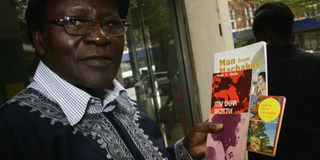Maillu’s ‘African Bible’ attempts to rewrite history

David Maillu holding with some of his books. In June last year, Kenyan writer David Maillu wrote, in this paper: “I was born and brought up when Kenya was a colony of the British. I experienced the pains of being colonised. PHOTO | FILE
What you need to know:
It is intriguing that Buddhists have a holy mountain in Cambodia they call Mount Meru, considered by their ancients to be the centre of the universe.
Our own Meru people live on Mount Kenya, which, standing right on the equator, may have been to the ancients who sailed to Cambodia long ago, the true ‘centre of the universe.’
In June last year, Kenyan writer David Maillu wrote, in this paper: “I was born and brought up when Kenya was a colony of the British. I experienced the pains of being colonised.
“I was there and celebrated when we got our independence and since then, living in the independent country, I have watched over the developments and underdevelopments the country has been making...”
David Maillu, born in October, 1939, as the Second World War started, has cause to worry, and that is why he has edited and contributed to a 500 page book called Ka,The Holy book of Neter (or the ‘African Bible’).
I don’t think any of the seven scholars contributing to this ‘African Bible’ had any intention of presenting it to the world as an alternative to the Jewish Bible used in our churches today. They wanted to show there was a great stock of religious beliefs and spiritual teaching long before the missionaries came.
After all, the very first missionaries, after the Apostles, were from Africa. One of them, Pantaenus, founder of a Christian school, went to India to preach the gospel, so the first missionary to India was from Africa.
So were the first settlers in India, thousands of years ago.
HOLY MOUNTAIN
It is intriguing that Buddhists have a holy mountain in Cambodia they call Mount Meru, considered by their ancients to be the centre of the universe.
Our own Meru people live on Mount Kenya, which, standing right on the equator, may have been to the ancients who sailed to Cambodia long ago, the true ‘centre of the universe.’
For the tribes living near Mount Kenya, it was the centre of the universe, being the home of Ngai, the one god they believed in and to whom they would sacrifice a ram without blemish, in time of war or famine.
The temples of India, Cambodia, Thailand and other places in South Asia, were certainly built by the black people who first settled there.
They have thousands of relief stone sculptures of Negroid people with broad noses who loved to dance with snakes coiled around their bodies.
The great sphinx of Egypt has negroid features.
When the Bible was first read to our fore-fathers, it seemed very familiar. Abraham and Ayub with their sheep and goats were familiar father-figures, who seemed to have lived very much like we did, praying to God on Mount Sinai and circumcising their youth as did many tribes of Africa.
It is on record that many missionaries bringing us the ‘good news’ helped in slave trade as slave labour in the newly discovered Americas was essential, black people being the only ones able to work in the sugar and cotton plantations.
Reading Ka: The holy Book of Neter will certainly help to restore a bit of Africa’s shaken and devastated morale.
The compilers’ mission was not to convert people to past, forgotten religious sects but to show that Africa always had a vast store of spiritual wisdom before the foreigners brought some of it back to the original source.
What is certain is that Africans were early contributors to Alphabet pulling out of the Nile papyrus reeds on which to write on.




